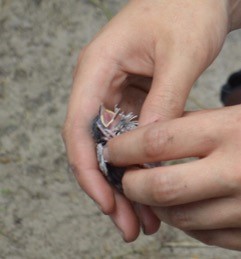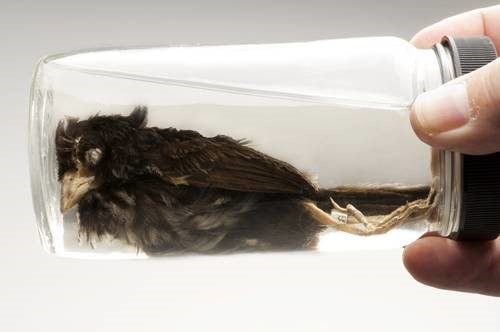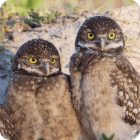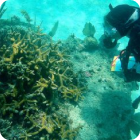
The Florida grasshopper sparrow (Ammodramus savannarum floridanus) is a nonmigratory subspecies of the grassland sparrow and is found only on the dry prairies of south-central Florida. The song of the Florida grasshopper sparrow sounds much like a grasshopper, which is where it gets its name. Males only sing a few hours a day during the breeding season to attract a female, and they often perch on grass stalks or dead palmetto fronds. Their song changes once they mate and begin building a nest, which helps scientists find their well-hidden nurseries.

The sparrow requires large treeless spaces dominated by bunch grasses, low shrubs, and saw palmetto with enough interspersed bare ground for this ground-dwelling bird to forage effectively. This habitat is dependent on frequent burning – so frequent, in fact, that sparrows very rarely nest on land that hasn’t burned within the last two years. The sparrows also prefer areas where palmettos density is low or where they have been mechanically disked to allow more grasses to dominate.
Around 40 nesting pairs remain in the wild, making the Florida grasshopper sparrow North America’s most endangered bird. Habitat fragmentation and loss due to development, lack of frequent prairie fires, storm-related flooding, and high nest predation rates have caused a dramatic decline in its population over the past 40 years.
Ground-nesting birds like the Florida grasshopper sparrow suffer high nest failure but are able to re-nest several times a year in response. They are responding well to a captive breeding program established by the U. S. Fish and Wildlife Service (USFWS) at nonprofit White Oak Conservation in Yulee, FL, which the Foundation, the Florida Fish and Wildlife Conservation Commission (FWC), White Oak, and others are helping fund. Each nesting pair at White Oak is producing an astounding average of nine fledglings/year. The first of these captive-reared sparrows began being released back into the wild in May 2019, in hope of stabilizing and growing the largest-remaining wild population of the birds. More than 300 birds have been released since 2019, with releases ongoing. As of June 2021, biologists have detected at least 60 released birds in the population, including both males and females. 65% of the birds hatched in the wild in 2020 had at least one captive-bred and released parent. Biologists are still collecting data for the 2021 breeding season, but numbers are expected to be similar to 2020.
FWC and USFWS scientists have developed predator-exclusion fencing to reduce loss of eggs and young birds to snakes, skunks, raccoons, and other predators. Fire ants are a growing problem; scientists are on perpetual look-out for their nests, which are treated with boiling water to kill the worker ants before digging up the nest to kill the queen.
During heavy rain events, water collects on the prairie. FWC and other scientists will raise each nest several inches to save it. If few successful nests are produced in a given season, it can have dramatic results on population decline.
WHY SHOULD WE CARE IF THESE SPARROWS DISAPPEAR?

Saving the Florida grasshopper sparrow from extinction is labor-intensive work, but the sparrow is worth it. It’s emblematic of Florida’s dry prairies, and its presence or absence is a reliable indicator of the health of the entire ecosystem.
Florida grasshopper sparrows are also intrinsically important as part of the biodiversity of Florida and North America. The loss of a species, as one scientist says, is like burning a book before reading it. Once gone, it can never be brought back.
That last happened thirty years ago, when Florida and the world witnessed the extinction of the dusky seaside sparrow. Last-minute efforts to save the bird through captive breeding came too late as all six of the remaining birds were males.
HOW CAN I HELP?
You can learn more about the Florida grassland sparrow and what’s being done to save it below. Let others know about it, and consider donating to our sparrow conservation fund.
MORE ABOUT SAVING THE FLORIDA GRASSHOPPER SPARROW

In June of 1987, a small black-and-white bird with a distinctive yellow stripe above its eye was found dead in his food bowl at the endangered species center in Walt Disney World, Florida. Named for the metal identifier on his leg, Orange was the world’s last dusky seaside sparrow. He had been captured in 1980 with five others, the last of a flock once numbering thousands. But biologists acted too late: Orange and his companions were all males. By the time humanity acted, all known females were gone.
North America is facing another avian extinction. In the last remaining dry prairies of south-central Florida lives the continent’s now most imperiled bird, the Florida grasshopper sparrow, Ammodramus savannarum floridanus. Threatened by predators, and since the 1970’s, significant habitat degradation and loss, fewer than 100 Florida grasshopper sparrows remain in the wild.
This is a race against extinction’s clock, a race this time we can win. The nonprofit Fish & Wildlife Foundation of Florida (FWFF), founded in 1994, is helping fund the work of scientists with White Oak Conservation, the Florida Fish and Wildlife Conservation Commission (FWC), and other organizations to save the sparrow. We have contributed $1,869,130 toward the best hope for sparrow survival – conservation (captive) breeding and release.
Conservation breeding is central to a five-year strategy to stabilize the sparrow’s wild population. Raising and releasing captive-bred birds also buys time to protect and restore more habitat, establish new wild populations, and better manage predators, parasites, and diseases that the birds are susceptible to. While our long-term goal is to make captive breeding unnecessary, without captive rearing now, models indicate the species will go extinct in the wild within ten years.
Unlike for many rare species, however, captive rearing of Florida grasshopper sparrows has proven a great success over its first four years. The sparrows are prolific breeders, an adaptation common among ground-nesting birds whose eggs and young even in the best of times suffer significant predation and occasional flooding. For such birds, safety is in numbers – the more birds on the landscape, the greater the odds of individual nests and young birds escaping notice by small mammals and snakes. By rearing birds in captivity, safe from predators and other dangers, then releasing them into the wild, biologists can greatly increase the odds that juvenile birds will reach breeding age.
Most of the conservation rearing is being done at 700-acre White Oak Conservation, Inc., in Yulee FL, near Jacksonville. Part of the 17,000-acre White Oak Plantation, nonprofit White Oak Conservation is a pioneer in the breeding and recovery of many species. At a hatch weight of one ounce, the Florida grasshopper sparrow is the smallest species White Oak has taken on.
Since entering the program in 2016, White Oak has perfected techniques for breeding, hatching, and rearing sparrows, and currently has the capacity to care for 14 breeding pairs. Each of these pairs in 2017 successfully fledged a staggering average of 9.3 juveniles per breeding season. Extreme care is taken to keep captive birds free of extra-intestinal coccidiosis, eastern equine encephalitis, and other avian diseases.

Preparing for Release: Fifty miles south of Orlando, within the country’s second-largest expanse of dry prairie, biologists have erected a temporary aviary to acclimate captive-reared birds before release into the wild. The first captive-reared birds were released into the largest remaining wild population in 2019.
 FWC biologists are tracking them and are using special fencing and other strategies to keep skunks, snakes, raccoons, and other predators from attacking nests. More than 300 birds have been released into the wild in the last three years, starting with the first releases in 2019. In songbirds, such as Florida grasshopper sparrows, juvenile survival is naturally low. Therefore, many of the released birds do not survive to the next year and many individuals need to be released to have a significant positive impact on the population.
FWC biologists are tracking them and are using special fencing and other strategies to keep skunks, snakes, raccoons, and other predators from attacking nests. More than 300 birds have been released into the wild in the last three years, starting with the first releases in 2019. In songbirds, such as Florida grasshopper sparrows, juvenile survival is naturally low. Therefore, many of the released birds do not survive to the next year and many individuals need to be released to have a significant positive impact on the population.
We and our partners are raising or otherwise contributing $1.7 million to support the full grasshopper sparrow program. This includes the captive breeding and release program (including $300,000 to expand the captive population); protection of the remaining wild nests; and continued research on avian disease, predator control, and other needs.
Captive conservation breeding programs saved the California condor and can also save its tiny Florida cousin. In recent years, biologists have learned how to protect and rear Florida grasshopper sparrows while maintaining or restoring their dry prairie habitat, a sufficient amount of which is in conservation ownership to support the bird’s continued existence. We have the land, the experts, and increasingly the knowledge and the technology to recover this species. We’re confident we can bring the Florida grasshopper sparrow back from the brink, and never have to watch helplessly as a future Orange grows old and dies along with all hope for its species.














